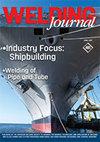Effect of Carbon on Stress-Relief Cracking Susceptibility of T23 Steel
IF 1.4
3区 材料科学
Q2 METALLURGY & METALLURGICAL ENGINEERING
引用次数: 0
Abstract
The coarse-grained heat-affected zone (CGHAZ) samples were prepared from T23 steel with three different carbon contents on a thermal simulator, then isothermal slow strain rate tensile tests were carried out at 500° ~ 750°C, and the effect of carbon content on the stress-relief cracking (SRC) sensitivity of T23 steel was evaluated according to fracture ductility. The microstructure evolution of the CGHAZs in the process of SRC was observed by optical microscopy, structural equation modeling energy-dispersive spectroscopy, and transmission electron microscopy energy-dispersive spectroscopy/selected area electron diffraction to reveal the mechanism of SRC. Finally, the feasibility of adjusting carbon content to prevent SRC was discussed. The results showed the classical theory of intragranular precipitation hardening cannot explain the cause of SRC, and a new viewpoint was put forward that the precipitation of M23C6 at the grain boundary was the main reason for SRC. The precipitation of M23C6 carbide cannot only provide a preferred site for void nucleation but also leads to the depletion of alloy elements in the matrix near the grain boundary. The interaction of these two aspects leads to the direct weakening of grain boundaries. Moreover, the SRC of T23 steel could be inhibited when the carbon content was determined to be close to the ASME standard lower limit of 0.04 wt-%. In summary, reducing the carbon content can inhibit the SRC sensitivity of T23 steel, which is not due to reducing the relative weakening of the grain boundary by reducing the precipitation hardening in the grain interior but to inhibiting the direct weakening of the grain boundary by reducing the precipitation of M23C6 at the grain boundary.碳对T23钢应力消除裂纹敏感性的影响
采用三种不同碳含量的T23钢在热模拟机上制备了粗晶粒热影响区(CGHAZ)试样,然后在500°~750°C下进行了等温慢应变速率拉伸试验,并根据断裂延性评价了碳含量对T23钢应力释放开裂(SRC)敏感性的影响。通过光学显微镜、结构方程建模能量色散光谱和透射电子显微镜能量色散光谱/选区电子衍射观察了SRC过程中CGHAZ的微观结构演变,揭示了SRC的形成机制。最后,对调整碳含量预防SRC的可行性进行了探讨。结果表明,经典的晶粒内沉淀硬化理论不能解释SRC的形成原因,并提出了M23C6在晶界的沉淀是SRC形成的主要原因的新观点。M23C6碳化物的沉淀不仅为空穴形核提供了优选的位置,而且还导致晶界附近基体中合金元素的耗尽。这两个方面的相互作用导致晶界的直接弱化。此外,当碳含量接近0.04 wt%的ASME标准下限时,T23钢的SRC可以被抑制。总之,降低碳含量可以抑制T23钢的SRC敏感性,这不是因为通过减少晶粒内部的沉淀硬化来减少晶界的相对弱化,而是因为通过减少M23C6在晶界的沉淀来抑制晶界的直接弱化。
本文章由计算机程序翻译,如有差异,请以英文原文为准。
求助全文
约1分钟内获得全文
求助全文
来源期刊

Welding Journal
工程技术-冶金工程
CiteScore
3.00
自引率
0.00%
发文量
23
审稿时长
3 months
期刊介绍:
The Welding Journal has been published continually since 1922 — an unmatched link to all issues and advancements concerning metal fabrication and construction.
Each month the Welding Journal delivers news of the welding and metal fabricating industry. Stay informed on the latest products, trends, technology and events via in-depth articles, full-color photos and illustrations, and timely, cost-saving advice. Also featured are articles and supplements on related activities, such as testing and inspection, maintenance and repair, design, training, personal safety, and brazing and soldering.
 求助内容:
求助内容: 应助结果提醒方式:
应助结果提醒方式:


